
Managing stormwater is a physics problem, and not a very glamorous one. In decades past, the main objective of managing stormwater was figuring out how fast it could be directed through the Bay Area’s built landscape via storm drains, culverts, and channels, and into the Bay. In decades future, however, the object will be to slow down the runoff, and sink it into greener, spongier surfaces sprinkled throughout our cities and counties, or to run it through more meandering, more natural channels and drainages. Such measures fall under the classification of green stormwater infrastructure. And building more green infrastructure isn’t just some kind of concept or vision. Instead, the region’s water quality regulators want to see more of it from local municipalities – enough to make it a requirement of another five-year federally-mandated permit to discharge stormwater.
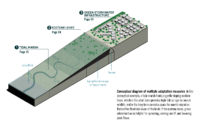
“The goal is to figure out how we can interrupt the conveyor belt of pollution caused by the grey- infrastructure storm drain system, in which pollutants in urban runoff are discharged to creeks and the Bay without treatment,” says Keith Lichten, Watershed Management Division chief of the San Francisco Bay Regional Water Quality Control Board. This September starts a new planning cycle for the board’s municipal regional permit (see sidebar). During the upcoming cycle, local municipalities will have to show they are compliant with the stormwater permit by incorporating green infrastructure into their future plans.
Of course green infrastructure has been around for eons, it just hasn’t been on the front burner for many urban planners. “This is an opportunity for cities to look at their new and redevelopment plans for the next 25-plus years and figure out ways to implement stormwater treatment controls by replacing grey infrastructure with green infrastructure,” says Lichten.
Green infrastructure is a loosey-goosey kind of term. Part of the reason is that green infrastructure is more like a set of design principles — or design outcomes, really, than it is a strict discipline. Part of the utility of green infrastructure, particularly with regards to stormwater management — where the goal is to slow, spread, and sometimes even store runoff — is that the same principles are scalable across different size projects.
Matt Fabry manages the San Mateo County-wide Water Pollution Prevention Program and he explains the three different scales at which green infrastructure is being developed in the Bay Area, or what he calls an “evolving state of practice for managing stormwater.”
The first is at the parcel or individual property level, particularly during any redevelopment. “The Water Board recognized that it is going to take time to change the urban fabric,” Fabry says. Beginning in 2005, the board required that new development or redevelopment that added or replaced 10,000 square feet or more of impervious surfaces had to have some way of locally managing runoff. The requirements started with on-site mechanical filtration but have since moved to a more landscape-based approach that includes green infrastructure tactics. While the parcel level is the smallest scale, the funding is also the simplest because the construction costs become part of the project budget. “Cities are looking at more ways can get this done with private dollars,” Fabry says.
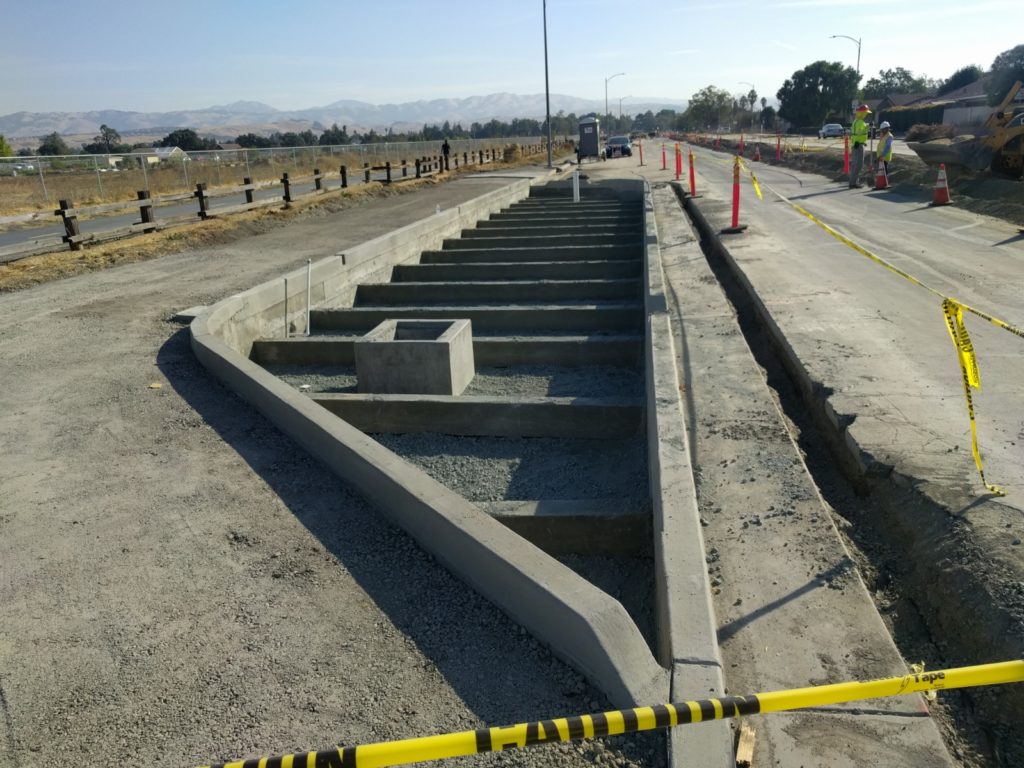
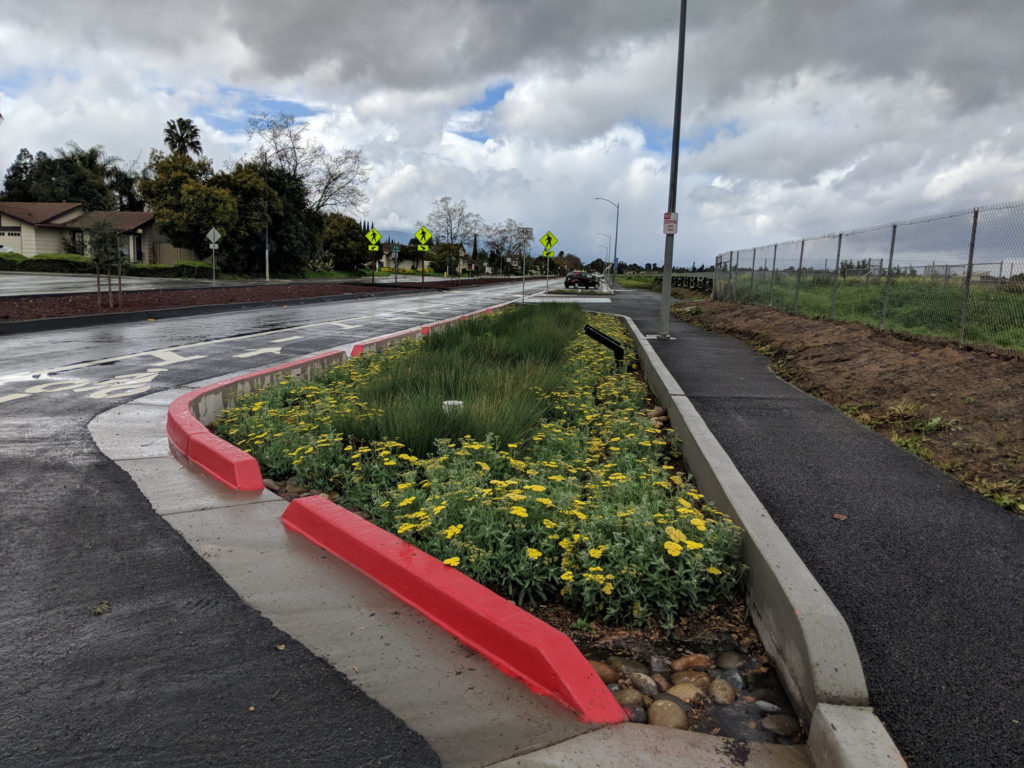
The second scale of green stormwater infrastructure development is happening at the street or neighborhood level. The definition of a comprehensive urban street continues to get more sophisticated. It began with a model called complete streets, which is more pedestrian and bike friendly. Then came the idea of green streets, which replaced hard impervious curbs and gutters with pockets of vegetation and deep wells around street trees that allows water to collect, and cuts in curbs to slow the flow of water. Those two concepts are now being married together into something called sustainable streets, which combines the goals of making streets more pedestrian and bike-friendly while layering the green infrastructure elements of slowing and spreading stormwater runoff. The sustainable streets model is currently being implemented in numerous cities around the Bay Area.

The third level of scale according to Fabry is happening at the city or watershed level. He points to a project in the design phase in South San Francisco, where city officials are working with San Mateo County Flood Control District to re-engineer part of Colma Creek. The creek, with its headwaters on the flanks of the San Bruno Mountains, currently drains about 6,500 acres, and while running through the busy blocks between the 280 and 380 freeways is confined to a hardened concrete channel. On its way to an outlet in the Bay near the San Francisco International Airport, the creek passes by the popular Orange Memorial park. The wide-open baseball and softball fields there provide the perfect testing ground for a massive green stormwater infrastructure project, but maybe not in the way you think. After years of planning and public input, the city and its partners are scheduled to break ground by early next spring on a project that will put a massive reservoir underneath one of the ball fields. Before the water hits the subsurface cistern it will be filtered to remove trash and pollutants, like the heavy metals targeted by the Regional Water Board. Roughly half of the water will be used to irrigate landscaping around the park and along the adjacent stretch of Centennial Trail, and the remainder will be allowed to slowly feed back into the region’s aquifers. Any of the filtered overflow will be diverted back to the concrete creek where it will eventually meet the Bay.
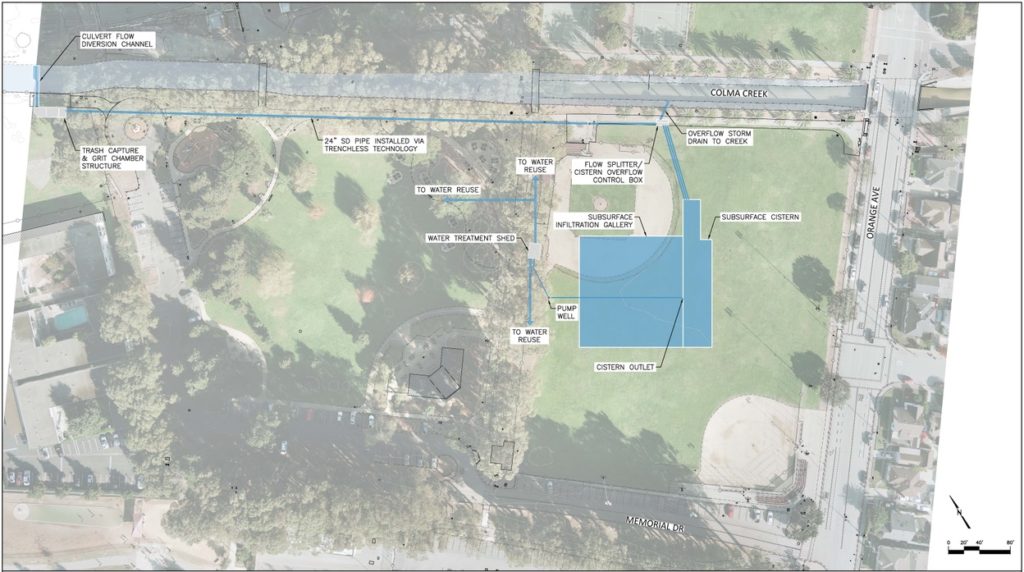
“In addition to the usual challenges encountered by public infrastructure construction, this particular project has unique elements requiring several rounds of public outreach and feedback” says Bianca Liu, Associate Engineer for the City of South San Francisco and project manager for the Orange Memorial Park stormwater capture project. “The idea of a giant underground storage tank in the neighborhood is a new concept, and the project will require the temporary closure of a portion of a popular park.”
If this mesh of projects all sounds a little ad-hoc, that’s because so far, green infrastructure development largely occurs on a case-by-case basis. Until now the nature of trying to build infrastructure has been inherently opportunistic, and the new Regional Water Board permitting process aims to change that by requiring long-term municipal plans. In reality, building any green infrastructure that crosses the boundaries of a single parcel often requires the coordination of multiple public agencies and several layers of permitting requirements.
There’s the additional wrinkle that green infrastructure can be complicated to fund, although both project planners and funding agencies are becoming more creative. “It’s amazingly expensive to retrofit the existing built environment especially when you are doing it as a standalone project,” says Josh Bradt, a watershed program manager for the San Francisco Estuary Partnership. “It only really pencils out when it is part of a bigger project.”

South San Francisco’s regional scale green infrastructure project is actually being funded by $9.5 million from Caltrans. Caltrans has their own water quality guidelines to meet, and if they can’t do enough on a specific project then they can find ways to offset impacts by funding a project elsewhere that will reduce runoff or pollution. “We need to be talking to the transportation community and natural resources community to see where these projects can be synced up. Right now, it’s a real jigsaw puzzle to figure out the funding sources,” Bradt says.
But relying on a connect-the-dots funding approach is changing. “As far as the funding goes, there are more bonds and grants out there for green infrastructure projects today than five to ten years ago, but maybe it’s time green infrastructure becomes a budget line item,” says Mitch Avalon, who formerly oversaw Contra Costa County’s clean water program. Avalon has been advocating for new state legislation that would formally integrate stormwater management into any future regional transportation projects and funding opportunities, and also working with regional agencies such as the Bay Area’s Metropolitan Transportation Commission on other avenues to achieve the same goals. He says the first step in that process is actually defining what integrating stormwater into transportation planning actually means on the ground. “If you are familiar with the Americans with Disabilities Act, you might remember that it was a big policy decision that required people to change the way things were built. At first, people thought that was crazy, but eventually compliance just became another line item in a construction budget,” Avalon says. “As a policy and as a society, we decided it was important.” The same thing is happening with green infrastructure funding.

Realistically, however, municipalities won’t suddenly be rolling out green infrastructure projects on every street corner or along every urban creek come September, when the Regional Water Board’s new planning requirements solidify.
Progress over the last decade has been much slower than some would have hoped. “It is frustrating to see conventional right of way projects continue to be undertaken without GI elements when the impacts of landscape hardening to watershed health are well known,” says the San Francisco Estuary Partnership’s Josh Bradt. “I am hopeful that the Water Board’s requirement for watershed-based GI master plans will be a game-changer. At the very least it should encourage much better coordination.”
Right now, cities fall along a spectrum of readiness, some report still being in the planning phase, while others are much farther along. “Oakland is prepared to meet the current regulations, says Kirstin Hathaway, acting Watershed and Stormwater Division Program manager for the City of Oakland. “We see green infrastructure as important for the city beyond the regulatory requirements.”
One factor that helps build enthusiasm among planners is that while the board’s permit requirements are focused on reducing urban runoff pollutants including PCBs, mercury, and trash from entering the Bay, there are many other compelling reasons for increasing the acreage of green infrastructure around the region.
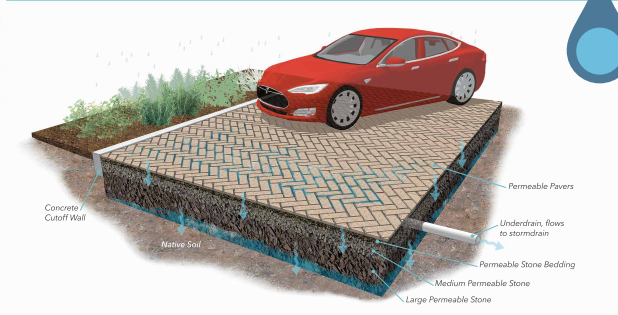
As described earlier, sustainable streets could not only reduce pollution but also add buffers that might be useful in a changing climate, such as more vegetation to help with heat island effects or a place to capture surge events that will likely happen secondary to sea level rise. And the larger, regional projects like the one underway at Orange Memorial Park can be used to capture and store stormwater that today might be used to irrigate a ball field, but in the future could be used for other purposes. Not to mention that green infrastructure just generally makes the built environment more comfortable and livable — a factor not always accounted for or built into project cost analysis.
“It takes a little bit of time to get these things baked together,” says Michael Germeraad, a resilience planner with the Metropolitan Transportation Commission and Association of Bay Area Governments, referring to how people are starting to talk about the advantages of green infrastructure as a means to accomplish multiple objectives. “As municipalities adopt plans in the next two years, I think we will see increased pressure to start including green infrastructure and planning so that one plus one equals three.”
And for some communities thinking about how to insulate against the impacts of climate change and sea level rise isn’t really about planning for the future — because the forecasted scenario of increased flooding has already arrived.
“We’ve actually had people kayaking in our streets,” says Elizabeth Patterson, the Mayor of Benicia where a citizen group called Sustainable Solano is leading the charge and training residents about resilience. “This is not just a reaction to regulations, not just because the state was saying you have to do this, a lot of municipalities are asking for help for this.”
Green Infrastructure Centerfold
Oakland green infrastructure vision. Photo: Kevin Robert Perry
During wet weather events, stormwater comes pouring down from Bay Area hillsides and collects in the lowlands. This makes sense because historically the fringes of the Bay were perfect catch basins for heavy flows. But starting more than a century ago those low-lying basin-like areas have been filled in with homes and buildings and with roads and parking lots. As the Bay Area became built and developed hard surfaces, greater quantities of runoff raced over the landscape.
Then, following the passage of the Clean Water Act of 1972, came the awakening that stormwater was more than just a flooding issue. The flows, it was acknowledged, could be laced with concentrations of toxins rivaling that of the end-of-pipe sources that the Clean Water Act was written to control. By the late 1980s, and after the passage of more federal water quality legislation, states were put in charge of making sure that municipalities were meeting stormwater requirements outlined by the National Pollutant Discharge Elimination System (NPDES), the regulatory teeth of the Clean Water Act.
In California, the State Water Resources Control Board and Regional Water Quality Control Boards are tasked with making sure that local agencies are operating in compliance with NPDES. Beginning in the 1990s, the San Francisco Bay board began issuing NPDES permits for municipal stormwater discharges, which eventually grew into the Municipal Regional Permit, also known as the MRP, as of 2009. The MRP requires Bay Area municipalities to clean up urban runoff pollution and, over time, to improve the way the urban environment is built to reduce the amounts of pollutants it discharges. And because the Bay Area has legacy contaminants from previous industrial and urban activities — particularly mercury and PCBs (both of which accumulate in food chains, especially fish, and pose health risk to the people that eat eventually eat the fish) — that get stirred up and carried to the Bay during storm events, the MRP targets those pollutants specifically, along with reducing the amount of trash that enters creeks and the Bay during storms.